NRES Junior Alondra Estrada Passionate About Environmental Science, Research, and…Turtles!
September 11, 2018
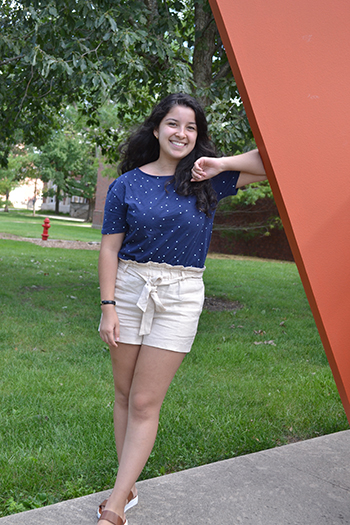
NRES junior Alondra Estrada.
Growing up in Adison, Illinois, Alondra Estrada, a first-generation Hispanic college student, wasn’t even sure she’d be going to college. Then she came to an Illinois summer camp and, as a result, changed her mind about becoming a veterinarian and decided to study environmental science instead. Then, for the last two summers, she participated in the WE CAN REU, which further muddied the waters regarding her next step careerwise. Should she become an animal photographer, go to grad school in environmental science, or go for her dream job, an environmental lawyer? While she isn’t sure what the future holds, she does know this: her many experiences have given her a lot of great career options.
While she hasn’t always been interested in environmental science, she says she’s always enjoyed being outside in the major parks near where she grew up. She started getting interested in science in middle school as a result of taking more science classes. Plus, though her high school only required a certain number of science courses, she decided to take an extra year, an AP environmental science class, which was her first real educational connection with the discipline.
Then, the summer before her junior year in high school, she came to the Ag Discovery program here at the University. It was because of that program that she switched from planning to study Veterinary Medicine to NRES (Natural Resources and Environmental Science).
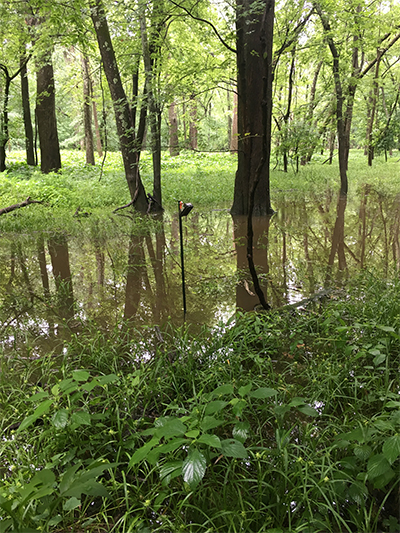
A small swamp in the woods where Estrada did her research on turtles for researcher Jinelle Sperry. Just in the center of the photo is the camera she used to video turtle predators. (Photograph courtesy of Alondra Estrada.)
The thing that intrigued her about environmental science was the material. “I liked the way everything was on the micro and macro scale, and it all interconnects in some way. It's not something that's technically made up like math or economics. It's not something that people created; it's something that we're learning from and still learning from. I just really like that idea of it.”
While she visited other campuses, she also credits the Ag Discovery program with her decision to matriculate to Illinois. “That program just made me feel very comfortable here,” she admits, “so because I already had a feel for the campus, and some of the staff, it just kind of made it an easier, more comfortable choice to make.” Plus, she also likes that it's not far from home.
“It provides a lot that I never even thought possible, so I have no regrets with my decision,” she says.
For instance, one really great opportunity she’s had while here at Illinois was participating in the NSF-funded WE CAN REU (Research Experience for Undergraduates) for the last two summers. The first summer she was on campus for six weeks prior to a 4-week trip to South Africa. The second summer was conducting research.
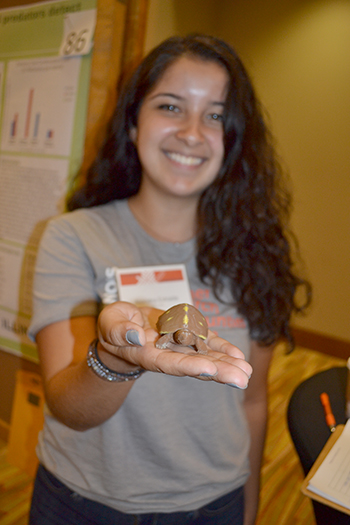
Alondra Estrada shows off the 3-D printed "turtle" she used in her research.
While on campus during the first summer in WE CAN, participants were to explore the different kinds of research they might be interested in doing the following summer. They were tasked with meeting researchers who might be willing to serve as mentors and allow them to help with research in their labs.
Estrada says that once she met with Jinelle Sperry, however, she cancelled the other meetings she had set up, telling herself, “This is it; this is what I've been looking for.”
Sperry works with amphibians and reptiles, particularly snakes and turtles, as well as birds, studying community-level ecological interactions with a focus on predator/prey dynamics.
Estrada’s project was a side project to help with the analysis of her mentor's main research project about different turtles in different habitats. “My job was to figure out how predators are finding them,” she explains.
While Estrada didn’t ever run across a turtle as a kid, she’s pretty passionate about them now. In fact, she did some work on her own time this spring, before her fellowship had even started, just swabbing the turtles: “That was fun, because I got to see all the turtles that were going to be put out in the field in Michigan,” she explains.
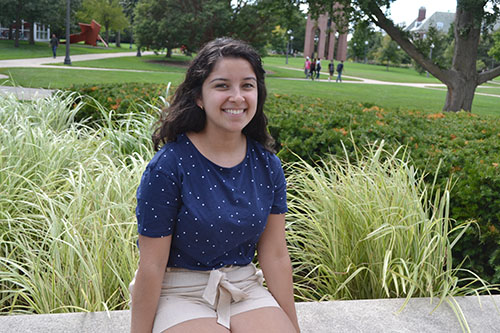
Alondra Estrada near the ACES library on campus.
Although her WE CAN fellowship ended this summer when she presented her poster at the Illinois Summer Research Symposium, since getting back on campus, she’s been “getting back into thue rhythm” doing some computing in order to finish her data analysis from this summer's research.
While participating in WE CAN didn’t necessarily help her decide on her career goals, Estrada says it definitely impacted her future plans. She says she had been wrestling with several different ideas regarding what she'd do after college—whether to go to grad school, or get a job, or follow her dream and go to law school. But she acknowledges that “This program really helped me plug in to a realistic perspective and really face reality that time is running out, I need to start doing all these things…I mean the next step. I've always been, 'Oh, it'll work out. I'll figure it out later.' But this program was, 'No, there's a time schedule you should work through.'”
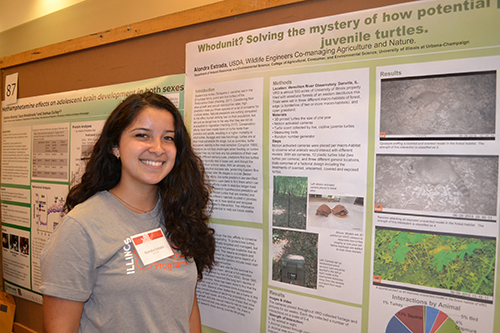
Alondra Estrada with her poster at the Illinois Summer Research Symposium.
In addition to a sense of urgency, the WE CAN program taught her what a career in research is like, indicating that it “definitely helped me realize how intense the science research field is.”
It also opened up a world of opportunities that are available to her, making her career decision even more difficult. “But honestly, I don't know if that helped me think about if I want to go to grad school, if I want to go to law school, just because it opened up so many more opportunities for me, that I'm so torn.”
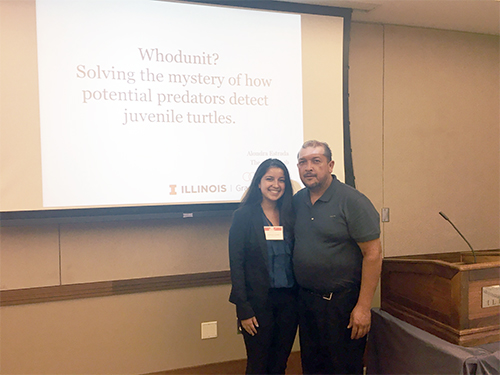
Alondra Estrada (left) with her father at her presentation for her research. (Photograph courtesy of Alondra Estrada.)
Did Estrada ever think when she was a kid that she'd be doing some of this stuff? “No. Growing up, I was never sure if I would go to college, just because of being a first-generation student...so I'm very lucky to be here. I never thought I'd be doing things like this. I never thought I would go to South Africa. I never imagined meeting the people I've met so far, building some friendships with professors like from the WE CAN program.” (Regarding many of these relationships she’s made with professors, she intends to keep in touch. In addition to enjoying the relationships she's built, she figures that within the next couple of years, once she makes that career decision, she'll be needing some good letters of reference!)
Estrada expresses gratitude for those who helped her on her journey: "I really owe a lot to the people in the guidance department of my high school, Addison Trail (Addison, IL). My counselor and the secretaries were my biggest support system, encouraging, guiding, and helping me become the person I am today. I wouldn't be at this university loving what I study if it weren't for them."
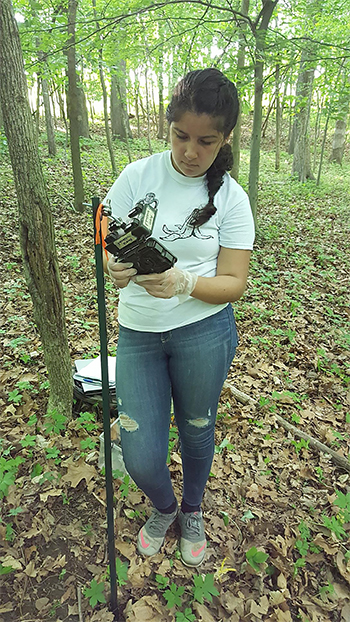
Alondra Estrada setting up a camera out in the woods where she studied turtles. (Photograph courtesy of Alondra Estrada.)
Author/Photographer: Elizabeth Innes, Communications Specialist, I-STEM Education Initiative
More: REU, Student Spotlight, Summer Research, Undergrad, 2018
For additional I-STEM web articles about REUs, see:
- Illinois Summer Research Symposium Showcases Undergraduates’ REU Experiences
- POETS REU Fosters Innovative Thinking to Change the Future of Power Dense Electronic Systems
- Undergrads Experience Open Source Software & Interdisciplinary Research Via INCLUSION REU
- WE CAN REU Provides Minority Students an International Experience, Research at the Intersection of Engineering and Agriculture
- Underrepresented Minority Undergraduate Students Gain Research, Clinical Experience Via the Carle Illinois College of Medicine’s New REACH RCEU
- REACH Program’s Emphasis of Research Plus Clinical Confirms Alexis Chamorro-Ortiz’s Career Goals: To Both Treat and Research Cancer













.jpg)
















